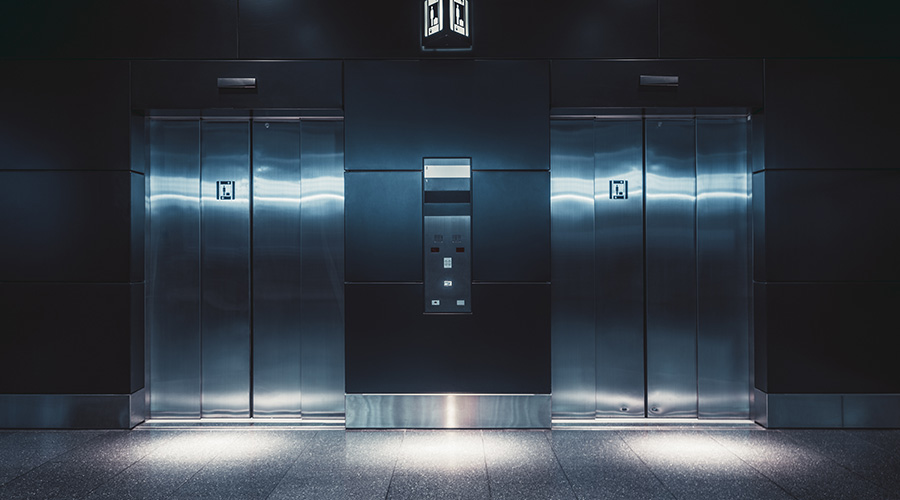Smoke, Water Remain Challenges to Evacuation Elevators
The industry will need to take other steps before evacuation elevators become commonplace. Keeping smoke and water out of the hoistway are two technical challenges. Changes made to NFPA 101 include performance-based requirements to obviate the problem, but it remains a concern.
“We want to maintain the integrity of the elevator system as long as possible,” says Brian Black, codes and safety consultant for National Elevator Industry Inc. (NEII). “How do we prevent water in the hoistway? As soon as water is pouring in there, occupants will be using the stairs.”
Other challenges deal with human behavior. Given the number of standard elevators already in operation, occupants need to know when they are in a building that has evacuation elevators. And even when a building has evacuation elevators, occupants need to know when an elevator can be used to evacuate and when the stairs should be used.
The American Society of Mechanical Engineers (ASME) A17 life safety code for elevators and escalators is responsible for governing how elevators operate, though ASME requirements have to be adopted at the local level. The problem is that while NFPA and ICC have made code changes defining evacuation elevators, ASME has not.
“The occupant egress system has not been developed at all for elevators,” says David McColl, chairman of the A17 task group on the use of occupant egress elevators. “It is talked about in the building codes, but nothing has been said about how the elevators will operate.”
What is clear so far, according to most experts, is that evacuation mode will only occur prior to what’s called Phase I. When smoke is detected in elevator lobbies or other key areas, elevators enter Phase I mode and automatically return to the ground floor. (See “When Fire Strikes” to the left).
Since 2004, ASME has been conducting a hazard analysis to determine how elevators might be safely used for evacuations. A related analysis is looking at whether fire fighters could use protected elevators to move close to a fire.
Basically, a hazard analysis is a process that looks at possible challenges to using an elevator to evacuate a building, and whether the challenges can be overcome so elevators can be used safely.
“It’s like starting with a tree trunk and having to follow each branch down to the leaf and then starting over to trace it to the next leaf,” says Paarlberg.
So far, the committees have developed more than 100 pages of documentation, McColl says.
Because the hazard analysis isn’t yet complete, it’s still uncertain how evacuation elevators will be used. “What concerns us is that the A17 elevator code has yet to address the issue,” says Black. “The package isn’t yet complete.”
What would have made more sense, Black says, is for ICC to wait until 2012 to change the code so that the ASME (an independent body) could have the A17 code governing elevator operations changed to match. “From our perspective, it should have been consistent,” he says.
Still, while the ASME A17 committee isn’t yet finished with its work, the action by ICC will likely speed up the process, McColl says.
“I think there is a lot of pent up demand to use the elevators like this,” says Bukowski. “People use elevators everyday, but they don’t understand how they work. We’ve posted all these signs in the lobby saying in case of fire, don’t use the elevators, but people don’t quite know why.”
What is known is that enough work on the hazard analysis has been done that, with the right changes, elevators can be used for evacuation. ASME expects to have recommendations for its own code changes sometime in 2009, McColl says.
“We feel it can be done pretty safely if the adequate precautions are taken,” McColl says. What will be key is making sure the elevators are protected from smoke and water, and that they have secure power supplies and communication with occupants, he says.
Change is Coming
NFPA’s code revisions to the NFPA Life Safety Code last month are another sign that, despite the challenges, evacuation elevators are coming. Some local jurisdictions use the International Building Code as a reference, while others use the NFPA code.
Among the changes NFPA made: Elevator lobbies will need to be enclosed and located directly adjacent to an exit stairwell. Elevator lobbies may also grow in size to accommodate occupants who have gathered for an evacuation. Sprinklers are also banned from evacuation elevator machine rooms.
While locating exit stairs adjacent to an elevator lobby may seem onerous, it need not be that difficult. That’s because most high rises locate elevators and stairwells in the core, says Coté of NFPA.
It’s important to note that the NFPA code changes aren’t required for all elevators — just those intended to be used for evacuation. What’s more, the provisions governing evacuation elevators in NFPA code — labeled Annex B — must be adopted separately from the rest of NFPA 101 by local code bodies.
Officials from ICC, NFPA and other industry organizations agree that aside from technology, educating occupants about when they can use an elevator to evacuate will be a major challenge.
“People need real-time messaging,” says Coté. “People won’t wait in an elevator lobby unless they have real-time information saying it’s worthwhile for them to stay there.”
Part of the challenge of course is that occupants are used to the scores of existing elevators that cannot be used for evacuation during a fire. But even under the new system, the rules won’t be clear-cut. If a fire prompts the elevators to enter evacuation mode, occupants could find they have to take the stairs if smoke from the fire or water enters an elevator lobby or hoistway. Hence the need for more sophisticated real-time communication systems in elevator lobbies.
“We really need to have a standard graphic symbol for these evacuation systems,” says Bukowski. “And then we really need to educate the public on the system.”
Having special elevators for the fire service could require additional training between the facility executive and local fire fighters, Coté says. For example, under the code, the fire service elevator could double as an evacuation elevator.
But if the local incident commander isn’t aware of the elevator system, he or she could unknowingly recall all elevators to the ground floor, suspending evacuation, Coté says. “The building owner is going to have to come to an agreement and do some pre-planning with the fire department,” he says.
Overall, while some details aren’t yet sorted out, facility executives shouldn’t lose sight of the big picture: Evacuation elevators are going to become another tool in making high-rises safer, if not an outright requirement in some cases. ASME, ICC and NFPA are all working towards that same destination.
“Maybe the standards and the codes aren’t in sync,” says Carl Galioto, partner with Skidmore, Owings and Merrill, the firm responsible for Freedom Tower and WTC7. “But it is all moving in the right direction. I think informed professionals can make the right judgment as to what the right features for a building should be.”
Related Topics:














